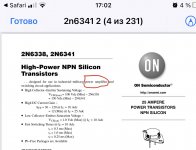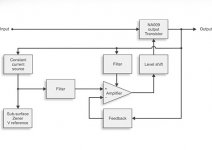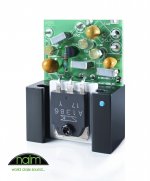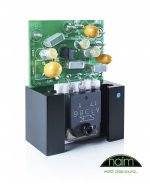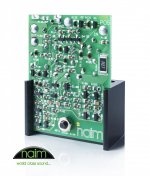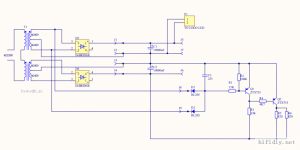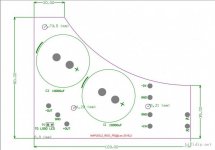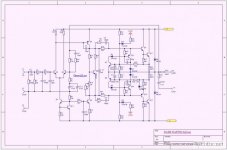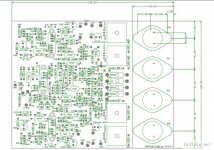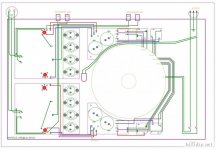“KTA/B/C/D” usually means 2SA/B/C/D of Korean origin. There are a lot of legitimate fabs there. Where most of the Fairchild stuff comes from.The transistors in the above pic, #337, will be cheap enough as they're only available from platform sellers but who made them and to what spec? I've bought a number of Chinese 2SD1047/B817 copies and most are way off Sanyo's spec. though they are clearly intended as copies of original Sanyo products - once used in almost every Rotel amplifier. FWIW, some samples branded K and sold as "KTD1047/KTB817" were actually quite good quality - I used them as replacements in pairs or full sets on a number of old designs, with mostly good results.
2N6341 - on semi say “for power amp”Ok ! Why not, i have some 15024 at 4Mhz too, not very fast. But how can we know if a transistor is linear ? In some case it's indicated in the datasheet as a linear transistor for audio application but when it's not indicated ?
I think need try this device
Attachments
Linearity is over-rated as a spec. 
All other things being equal, Ft and junction capacitance are more important.
Krell used to use the MJ15022 family.
For a PA system that needs to be bomb-proof I wouldn't use a Naim design. I'd go for low feedback and lots of output transistors.
All other things being equal, Ft and junction capacitance are more important.
Krell used to use the MJ15022 family.
For a PA system that needs to be bomb-proof I wouldn't use a Naim design. I'd go for low feedback and lots of output transistors.
On-semi probably means linear motor drivers.2N6341 - on semi say “for power amp”)
I think need try this device
You have to measure them yourself if the supplier has no specific data apart from a page or two of leading generic type figures published by "Savant IC"(this isn't a manufacturer but a marketing, sales and business development service for many small businesses like platform parts sellers and recyclers trying to market their goods). Generic products are offered as if they were retail items in a market stall, just un-branded or laser marked as necessary, to suit current market trends. This is why serious DIYs and service techs don't buy the generic, alleged copies - they buy genuine product from authorized distributors and know what they are getting instead of wrecking products with multiple attempts to repair with unsuitable fakes and guesswork.Ok ! Why not, i have some 15024 at 4Mhz too, not very fast. But how can we know if a transistor is linear ? In some case it's indicated in the datasheet as a linear transistor for audio application but when it's not indicated ?
If you have the time and budget to experiment by sacrificing some of the parts, fine. You can learn a few things about fakes, some of the people who trade them and whether they are offering outright fakes, variable quality, good/ bad quality or just unsuitable for your purpose that way too.
Everyone is a potential sucker for bargain priced components but when they arrive and aren't even close to what you need, the cost just increased by that of correct parts and wasted more time. So, you get tired of being ripped off just because you don't read datasheets but more important, is the fundamental difference between Chinese marketing of generic components to DIY dabblers and a repairer's serious need to find similar if not the original type parts, through bona fide agencies.
Let's consider the Naim design. It uses bipolar output transistors in near class B. It's not going to be very linear by design. This is not important to this design...Naim biases the transistors into a just-on state to avoid severe non-linearity, but that's all it needs. The NFB compensates.
Julian Vereker was always receiving improvement suggestions from all and sundry. One he told me about was to put a speaker fuse at the output for added protection. He said you could do that but you should put the NFB sense point on the speaker side of the fuse to reduce the effect of the fuse's non-linearity.
Julian Vereker was always receiving improvement suggestions from all and sundry. One he told me about was to put a speaker fuse at the output for added protection. He said you could do that but you should put the NFB sense point on the speaker side of the fuse to reduce the effect of the fuse's non-linearity.
Big PA amplifiers usually use output triples and local feedback loops inside the global feedback. Output transistor linearity is almost a non issue. The Naim designs were tuned in for specific transistor characteristics.
Linear motor drivers may not require spectacularly high VCE. Any transistor has good enough SOA at 10 or 20 volts, even the fast ones.
“Savant IC” is something like ECG, where they get their parts anywhere they can. Sometimes legit sources, sometimes not. If the REAL one is unobtainium, they can’t get it either. They have some level of quality control, but you are rolling the dice.
Linear motor drivers may not require spectacularly high VCE. Any transistor has good enough SOA at 10 or 20 volts, even the fast ones.
“Savant IC” is something like ECG, where they get their parts anywhere they can. Sometimes legit sources, sometimes not. If the REAL one is unobtainium, they can’t get it either. They have some level of quality control, but you are rolling the dice.
Ty ian, I buy my components only on mouser/farnell/RS to avoid fakes parts but MJ15024 are salvage parts on a old Hill power ampYou have to measure them yourself if the supplier has no specific data apart from a page or two of leading generic type figures published by "Savant IC"(this isn't a manufacturer but a marketing, sales and business development service for many small businesses like platform parts sellers and recyclers trying to market their goods). Generic products are offered as if they were retail items in a market stall, just un-branded or laser marked as necessary, to suit current market trends. This is why serious DIYs and service techs don't buy the generic, alleged copies - they buy genuine product from authorized distributors and know what they are getting instead of wrecking products with multiple attempts to repair with unsuitable fakes and guesswork.
If you have the time and budget to experiment by sacrificing some of the parts, fine. You can learn a few things about fakes, some of the people who trade them and whether they are offering outright fakes, variable quality, good/ bad quality or just unsuitable for your purpose that way too.
Everyone is a potential sucker for bargain priced components but when they arrive and aren't even close to what you need, the cost just increased by that of correct parts and wasted more time. So, you get tired of being ripped off just because you don't read datasheets but more important, is the fundamental difference between Chinese marketing of generic components to DIY dabblers and a repairer's serious need to find similar if not the original type parts, through bona fide agencies.
NCC200 uses MJ15003.MJ15003 is “good”, but not what’s needed to clone one of these amplifiers.
Here is what I found about DR:
Attachments
Last edited:
Maybe if I have of back side photos of 250DR PCBs I make pcb copy
If you can make a working DR schematic please post here, or at least PM me
Attached new NAP250 schematics, reverse engineered by a member of a chinese forum:
Attachments
Nice research, guys. Here's the DR's power transistor:
https://www.semicon.sanken-ele.co.jp/sk_content/2sa1386_ds_en.pdf
https://www.semicon.sanken-ele.co.jp/sk_content/2sa1386_ds_en.pdf
Maybe that's the NPN complement?Nice research, guys. Here's the DR's power transistor:
https://www.semicon.sanken-ele.co.jp/sk_content/2sa1386_ds_en.pdf
https://www.semicon.sanken-ele.co.jp/sk_content/2sc3519_ds_en.pdf
Odd. It seems to me the DR's pass transistor is operated in collector-follower mode. So the unregulated input voltage is fed to the emitter and the output is taken from the collector. This means the output impedance is mainly derived from NFB. This also implies the output of the amplifier stage is moving up and down with the input voltage.
In a typical regulator the pass transistor is in emitter-follower mode so that its base voltage closely tracks the output voltage, isolated from the input voltage by the CB junction of the pass transistor.
The 2SA1386 is PNP so...
In a typical regulator the pass transistor is in emitter-follower mode so that its base voltage closely tracks the output voltage, isolated from the input voltage by the CB junction of the pass transistor.
The 2SA1386 is PNP so...
Yes it looks pretty similar in the datasheet. The NPN is faster and has less capacitance, which is not untypical.Maybe that's the NPN complement?
https://www.semicon.sanken-ele.co.jp/sk_content/2sc3519_ds_en.pdf
- Home
- Amplifiers
- Solid State
- NAP250 clone
